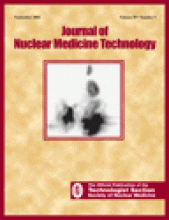Abstract
Objective: The aim of this article is to provide a general method to help explain radiation exposure to patients presenting for nuclear medicine procedures. The concept is to convert the effective dose from any nuclear medicine procedure to the equivalent time in months or years to obtain the same effective dose from background radiation.
Methods: The effective dose of each common diagnostic nuclear medicine procedure was obtained from the literature and the corresponding background equivalent radiation time (BERT) was calculated assuming an average background radiation of 3 mSv/y.
Results: A table of the BERT has been compiled for common nuclear medicine procedures.
Conclusion: The BERT table provides a simple approach to help physicians and technologists effectively communicate radiation exposure information and perhaps potential radiation risk.
One of the difficulties nuclear medicine physicians and technologists often encounter is how to explain the radiation dose from nuclear medicine procedures to patients. It appears there is no standardized explanation regarding radiation exposure in most nuclear medicine departments, and some physicians and technologists simply avoid the topic. In this article, a simple explanation of radiation exposure is given by using the concept of effective dose and the natural background radiation exposure. The concept of effective dose (previously called effective dose equivalent) was created by the International Commission on Radiological Protection in 1977 in an attempt to supply a relative risk of radiation exposure for nonuniform exposure by taking into account the type and energy of the radiopharmaceutical and the sensitivity of each organ to radiation (1). For example, neutrons are thought to be more detrimental than photons and thus are given a higher value of effective dose. Among the organs and tissues, gonads are more sensitive than other organs and have a higher weight in effective dose. The effective dose is intended to provide a single-value estimate of the overall stochastic risk (i.e., the total risk of cancer and genetic defects) of a given irradiation, whether received by the whole body, part of the body, or 1 or more individual organs. An extensive review of the concept and the calculation of effective dose can be found elsewhere (2,3). The use of the effective dose concept facilitates communication between professionals but is difficult for patients to comprehend. Recently, attempts have been made to compare radiation exposure from radiographic procedures with the background equivalent radiation time (BERT) (4). For instance, if we assume that the average background radiation is 3 mSv annually and a routine chest x-ray gives an effective dose of 0.08 mSv, then the radiation from a chest x-ray is equivalent to 10 d of radiation exposure from nature. In our approach, instead of telling a patient that he or she has received 7 mSv of radiation from a bone scan, we could explain to the patient that radiation exposure from the bone scan is equivalent to 2 y of radiation from nature.
Although the background radiation rate varies significantly from 1 geographic area to another, the average natural exposure rate in the Unites States is approximately 3 mSv/y, including contributions from cosmic, terrestrial, and internal exposures. The biggest source of natural background radiation is radon gas, which seeps into the basement of houses from rocks underground and contributes 2 mSv/y in the United States (5,6). Table 1 provides examples of variations in natural background radiation in a few areas in the United States.
Variation of Component of Natural Background Radiation Originating from Earth’s Crust in United States and World
METHODS
In this study, the BERT for each common diagnostic nuclear procedure was calculated assuming the background radiation rate of 3 mSv annually. The effective doses of most nuclear medicine procedures were obtained from literature (7,8). The distribution of sulfur colloid aerosol for ventilation lung scan was obtained from Prato and Vinitski (9) and the tissue-weighting factor of trachea (10) was used to calculate the effective dose of a ventilation scan. The final calculation was adjusted to the radiopharmaceutical doses currently used in our institution. The reader can apply the following formula to calculate the BERT for each nuclear medicine procedure:

Results
In Table 2, the effective doses and the corresponding BERT values are listed for common diagnostic nuclear medicine studies in adults.
Effective Dose and BERT
Discussion
Radiation is a natural phenomenon and we are exposed continuously. The simple approach outlined in this article can help nuclear medicine physicians and technologists answer patients’ questions regarding radiation exposure in a way that is easy to understand. In addition, Table 2 provides information that may be helpful in assessing ethical issues and radiation safety concerns in research projects. However, the reader should be aware of several modifying factors. First, the detrimental effect of radiation exposure is closely associated with the dose rate. It is well known that low dose rates produce fewer mutations, and there is evidence that suggests low doses may actually reduce the chance of cancer (11,12). Consequently, the BERT method simply provides a comparison instead of directly predicting radiation risk. Second, the background radiation rate can vary as much as 50 times depending on geography (4); therefore, the BERT values in Table 2 are not accurate for all regions of the world. However, the reader can still apply the information in Table 2 to calculate the BERT value using the formula provided in the Methods section. Third, the traditional application of the MIRD schema to calculate the effective dose has proven to be adequate for the diagnostic procedures but may not be accurate for therapeutic radiation dosimetry (2). Consequently, therapeutic nuclear medicine procedures were not included in this study.
Acknowledgments
The author thanks Dr. Albert Driedger for continued inspiration and discussion, and thanks Pamela Zabel and Dr. Adel Mattar for helpful comments.
Footnotes
For correspondence or reprints contact: Wanzhen Zeng, MD, PhD, Nuclear Medicine, University Campus, 339 Windermere Rd., London, Ontario, Canada N6A 5A5; Phone: 519-685-8500, ext. 33433; E-mail: Wzeng2{at}uwo.ca.







